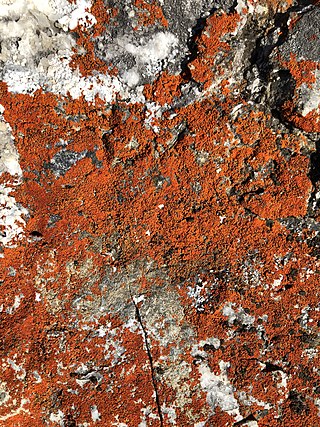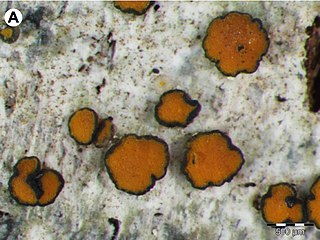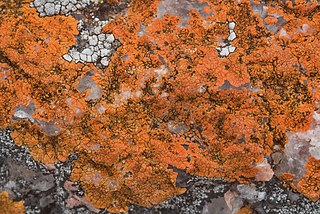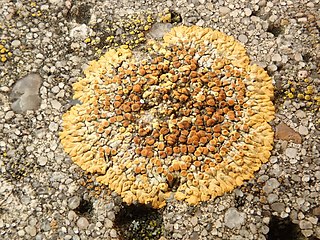
The Teloschistaceae are a large family of mostly lichen-forming fungi belonging to the class Lecanoromycetes in the division Ascomycota. Many members of the Teloschistaceae are readily identifiable by their vibrant orange to yellow hue, a result of their frequent anthraquinone content. The presence of these anthraquinone pigments, which confer protection from ultraviolet light, enabled this group to expand from shaded forest habitats to harsher environmental conditions of sunny and arid ecosystems during the Late Cretaceous. Collectively, the family has a cosmopolitan distribution, although members occur predominantly in subtropical and temperate regions. Although most members are lichens that either live on rock or on bark, about 40 species are lichenicolous fungi–meaning they live on other lichens.

Caloplaca is a lichen genus comprising a number of distinct species. Members of the genus are commonly called firedot lichen, jewel lichen. gold lichens, "orange lichens", but they are not always orange, as in the case of C. albovariegata. The distribution of this lichen genus is worldwide, extending from Antarctica to the high Arctic. It includes a portion of northern North America and the Russian High Arctic. There are about thirty species of Caloplaca in the flora of the British Isles.
Fulgogasparrea decipioides is a species of lichen in the family Teloschistaceae. It is found in Gangwon Province, South Korea. This species was originally described in 2011by Ulf Arup as a member of the large genus Caloplaca. The specific epithet decipioides refers to its similarity with Caloplaca decipiens. Arup and colleagues transferred it to genus Wetmoreana in 2013, before it was again transferred to Fulgogasparrea that same year, a genus in which it is the type species.

Gyalolechia is a genus of lichen-forming fungi belonging to the family Teloschistaceae. It contains 18 species of crustose lichens.

Igneoplaca is a genus in the subfamily Xanthorioideae of the family Teloschistaceae. It contains a single species, the crustose lichen Igneoplaca ignea.

Ikaeria is a genus of two species of crustose lichens in the family Teloschistaceae. Both species grow on twig bark of shrubs and trees. It was circumscribed in 2017 by lichenologists Sergey Kondratyuk, Dalip Kumar Upreti, and Jae-Seoun Hur, with Ikaeria aurantiellina assigned as the type species. This lichen was previously placed in the genus Caloplaca, but molecular phylogenetic analysis showed that it belonged in a lineage that was genetically distinct from that genus. Ikaeria serusiauxii was added to the genus in 2020.

Fulgogasparrea is a genus of crustose lichens in the subfamily Xanthorioideae of the family Teloschistaceae. It has five species. The genus was circumscribed in 2013, with Fulgogasparrea decipioides assigned as the type species; this lichen had originally been formally described as a species of Caloplaca, and then a couple of years later transferred to Wetmoreana. Six are credited with authorship of the genus: Sergey Kondratyuk, Jeong Min-hye, Ingvar Kärnefelt, John Alan Elix, Arne Thell, and Jae-Seoun Hur. The genus name alludes to the resemblance of the type species with both of the Teloschistaceae genera Fulgensia and Gasparrinia.

Lendemeriella is a genus of crustose lichens in the subfamily Caloplacoideae of the family Teloschistaceae. It has ten species. The genus was circumscribed in 2020 by Sergey Kondratyuk, with Lendemeriella reptans assigned as the type species. The genus name honours the American lichenologist James Lendemer, who co-authored the type species in 2012.
Huneckia is a genus of crustose lichens in the subfamily Caloplacoideae of the family Teloschistaceae. It has four species.
Villophora is a genus of lichen-forming fungi in the subfamily Teloschistoideae of the family Teloschistaceae. It has 9 species. The genus was circumscribed in 2013 by Ulrik Søchting, Ulf Arup, and Patrik Frödén. They assigned Villophora isidioclada as the type, and at that time, only species in the genus. This lichen, previously classified in Caloplaca, is found in South America, Antarctica, and some subantarctic islands. Several additional species were added to the genus in 2021. The generic name Villophora means "carrying filaments".

Calogaya pusilla is a species of saxicolous (rock-dwelling), crustose lichen in the family Teloschistaceae. It was originally formally described in 1852 by Italian lichenologist Abramo Bartolommeo Massalongo, who placed it in genus Physcia. The type specimen was collected in Veneto, Italy. It has undergone several changes of genus in its taxonomic history, including transfers to Caloplaca, Placodium, and Teloschistes. In 2013, it was placed in the newly circumscribed genus Calogaya.

The following outline provides an overview of and topical guide to lichens.
Mark Richard David Seaward is a British ecologist and lichenologist. He was awarded the Acharius Medal in 2006 for lifetime contributions to lichenology.

Wetmoreana is a genus of lichen-forming fungi in the family Teloschistaceae. It has two crustose, saxicolous (rock-dwelling) species.
Catenarina is a genus of lichen-forming fungi in the family Teloschistaceae consisting of three species. These crustose lichens are characterized by their reddish-brown pigmentation and the presence of the secondary compound 7-chlorocatenarin. The genus is found in the southernmost regions of the Southern Hemisphere, including Antarctica, southern Patagonia, and the Kerguelen Islands.

Niorma is a genus of lichen-forming fungi in the family Teloschistaceae. It has six fruticose species, with N. derelicta assigned as the type species. The genus was originally proposed by Italian lichenologist Abramo Bartolommeo Massalongo in 1861, but this and several other genera he proposed were largely ignored by later contemporaries. As part of a molecular phylogenetics-led restructuring of the teloschistoid clade of the subfamily Xanthorioideae in the Teloschistaceae, Sergey Kondratyuk and colleagues resurrected the genus for use about 150 years later. Genus Niorma comprises what was previously known as a species complex centred around the taxon previously known as Teloschistes hypoglaucus.

Wetmoreana brouardii is a species of saxicolous (rock-dwelling), crustose lichen in the family Teloschistaceae.
Xanthoria yorkensis is a species of corticolous (bark-dwelling), crustose lichen in the family Teloschistaceae. Found in South Australia, it was formally described as a new species in 2009 by lichenologists Sergey Kondratyuk and Ingvar Kärnefelt. The type specimen, collected along the Maitland road in Yorke Peninsula, was found growing on Melaleuca trees in mallee scrub. The species epithet refers to its type locality, the only place the lichen is known to occur. Kondratyuk and colleagues proposed to transfer the taxon to the newly circumscribed Jackelixia in 2009, but this genus has not been widely accepted by other authorities.
Xanthoria kangarooensis is a species of corticolous (bark-dwelling), crustose lichen in the family Teloschistaceae. Found in Australia, it was formally described as a new species in 2009 by lichenologists Sergey Kondratyuk and Ingvar Kärnefelt. The type specimen was collected from East Kangaroo Island, where it was found growing on dead Lycium ferocissimum shrubs. Other associated lichens include species of Pyxine, Ramalina, and Rinodina. The species epithet kangarooensis refers to its type locality, the only place the lichen is known to occur. Kondratyuk and colleagues proposed to transfer the taxon to the newly circumscribed Jackelixia in 2009, but this genus has not been widely accepted by other authorities.
Marchantiana is a genus of lichen-forming fungi in the family Teloschistaceae. It contains seven species of corticolous (bark-dwelling), crustose lichens that occur in the Southern Hemisphere.











